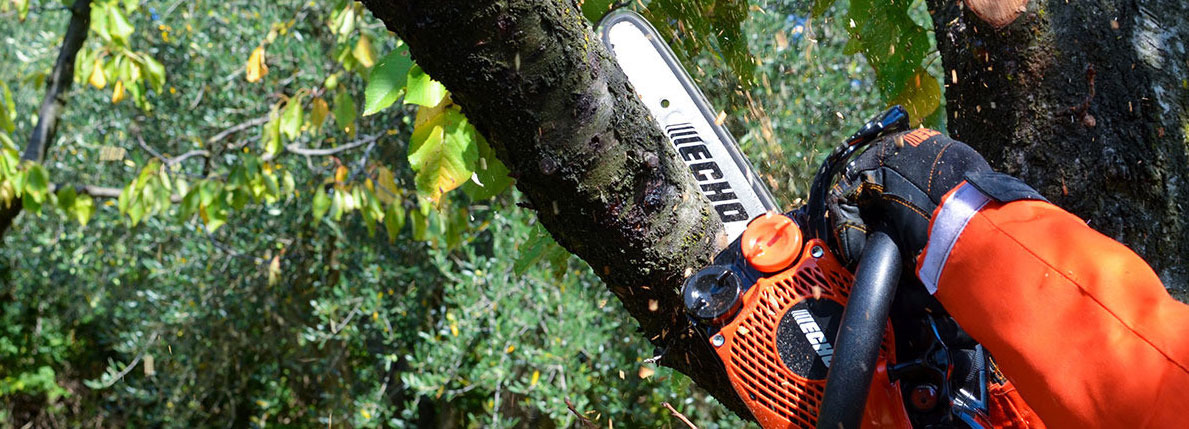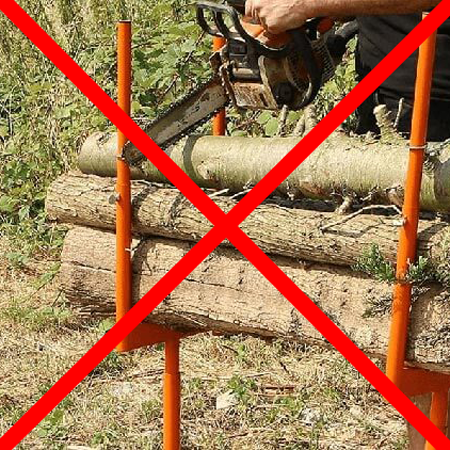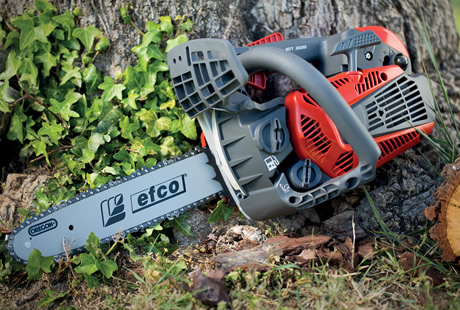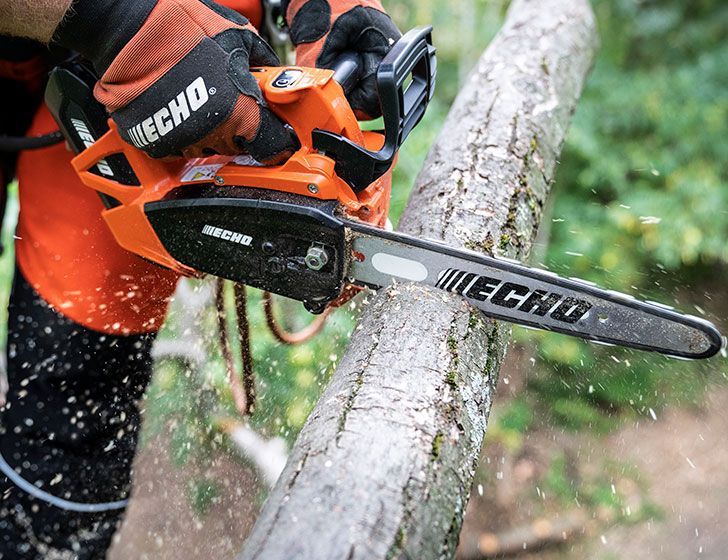A complete guide to purchasing a pruning chainsaw. When to use it? What sets it apart from a classic chainsaw?
The Complete Guide to help you choose the Best Chainsaw for Pruning
by the Real Experts of Wood Cutting Machinery
CONTENTS
1. Introduction
The chainsaw for pruning is ideal for trimming the branches of fruit trees, hedges and olive trees. Lightweight and handy, it is a tool designed to carry out fast and precise pruning treatments.
Chainsaws for pruning, although small, require careful handling. As mechanised cutting tools, they can be quite dangerous, especially for less experienced operators. Our first suggestion is to carefully read the instructions manual of the tool before use, and to use all the necessary protective equipment to avoid accidents.
These tools are immediately recognisable from larger chainsaws by their handle, which is located at the top. The tool can be operated with one hand, which makes it versatile and suitable for people who have never used a chainsaw before.
2. What is a chainsaw for pruning used for?
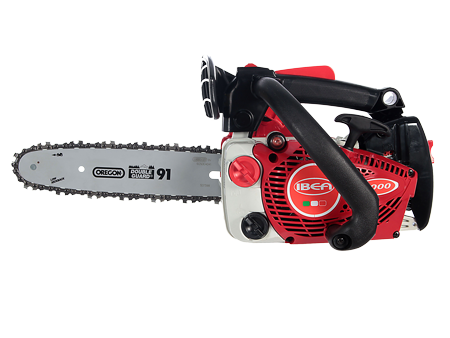
Chainsaw for pruning 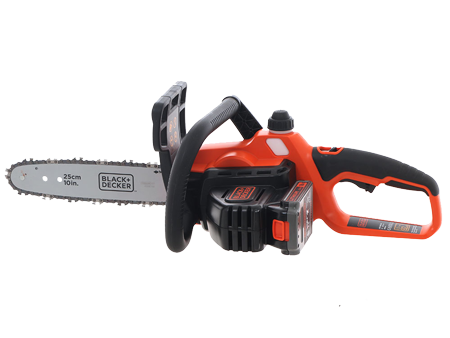
Chainsaw for cutting
Chainsaws for pruning are a good complement to their bigger cutting counterparts, but their use is strictly for smaller branches. They are therefore NOT suitable for cutting stumps on a log horse or for felling logs.
The upper handle, very similar to that of a flatiron, due to the increased balance it gives the chainsaw, is designed to make clearing branches from olive trees, fruit trees or garden hedges quicker and easier.
However, the use of this tool with one hand is strongly recommended for pruning professionals. It is no coincidence that every instructions manual recommends that the chainsaw should only be operated with one hand if the operator is sufficiently well acquainted with these tools. Conversely, beginners are encouraged to use chainsaws for pruning with both hands, in order to maintain greater control over the machine’s movements.
Users already familiar with chainsaws, however, will immediately notice the considerable difference in the way a model for pruning is handled compared to a chainsaw for cutting.
The handle of a chainsaw for pruning extends across the body of the machine, running along the top. Lifting the machine from the centre of the handle will ensure that the chainsaw is perfectly balanced. However, most models include an additional lifting handle for those who prefer to use both hands when operating the chainsaw.
On the other hand, as can be seen from the picture, a chainsaw always features two different handles: one located at the base of the unit and one located above the cutting bar.

Chainsaw for pruning 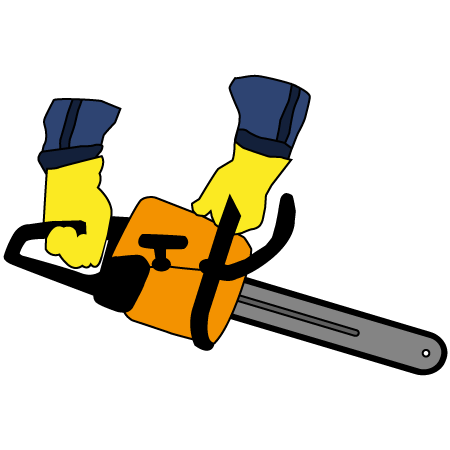
Chainsaw for cutting
To meet the varying degrees of professionalism required by operators, chainsaws for pruning on the market range in a number of quality positions. Consequently, they can be categorised into different price ranges.
As we shall see, most of the chainsaws for pruning on the market are equipped with 2-stroke engines, of variable power. The 2-stroke engines fitted on a chainsaw for pruning feature a cubic capacity that ranges between 18 and 40 cm³. As the cubic centimetres of engine capacity grow, the overall weight of the machine generally also increases.
However, this is not always the case: a chainsaw for pruning must always maintain a very accessible weight in order to serve its main purpose. This is necessary, as this tool is intended to be used with one or both arms raised. The aim of manufacturers then becomes that of causing as little fatigue as possible to the users.
There are therefore many suppliers who, in the case of a larger displacements, choose components that are as lightweight as possible. In this way, the final weight of the chainsaw is cushioned and the resulting product is easily lifted by anyone, with adequate power for small diameter branches.
Before looking more closely at this useful tool, a table and images will give an overview of the various chainsaws for pruning. By dividing these tools into different ranges, it will be easier to understand which model is the best for your needs.
| CUBIC CAPACITY | WEIGHT | NOMINAL POWER |
| up to 26 cm³ | 2.3 Kg/ 3.5 Kg | up to 2.0 Hp |
| 26 cm³ to 30 cm³ | 2.9 Kg/ 3.6 Kg | up to 2.0 Hp |
| 30 cm³ to 35 cm³ | 3.2 Kg | up to 1.5 Hp |
| 35 cm³ to 40 cm³ | 3.5 Kg/ 4.4 Kg | 1.5 Hp to 3.0 Hp |
3. What are the main features to consider before moving on with the purchase?
There are many models of chainsaws for pruning available, and they come with very different technical features. It is therefore necessary to carefully consider at least the key elements for your choice.
3.1 Engine or motor power supply
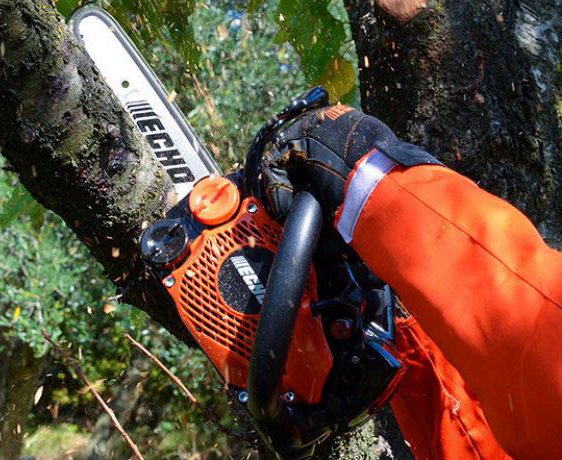
2-stroke chainsaws for pruning mount a 2-stroke oil-fuel mix engine. These are undoubtedly the most popular and sought-after models among customers.
This is mainly due to the higher power output, for the same cubic capacity, compared to both 4-stroke engines and battery-powered chainsaws.
The 2-stroke chainsaw for pruning is particularly targeted at pruning professionals who are used to working in large orchards, olive groves or forests.
On the other hand, of course, the weight is heavier than that of a battery-powered chainsaw and maintenance is more demanding.
The 2-stoke chainsaw for pruning ensures maximum efficiency and long working range, combined with greater freedom of movement. This tool allows you to work at high humidity levels and in all weather conditions. By its very nature, it is a heavier machine designed for more experienced users.
The unpleasant emissions produced by this type of chainsaw, due to the use of a mixture of oil and petrol, must also be taken into consideration. It is also a noisier tool than the other types. In order to remain efficient and functional over time, a 2-stroke chainsaw requires constant maintenance operations, such as topping up the oil tanks.
A separate area is taken up by battery-powered chainsaws for pruning, which are the latest to hit the market. These are avant-garde products, designed to offer maximum freedom of movement and great lightness, without sacrificing performance quality.
These chainsaws are powered by lithium batteries, and are becoming increasingly popular due to the many advantages they offer:
- More and more manufacturers are introducing battery sharing, whereby several pieces of equipment of the same brand can be powered by a single battery. This guarantees a considerable saving of money: by purchasing only one battery pack, you can power a wide range of power tools.
- The lithium batteries guarantee great autonomy, feeding the chainsaw for pruning so that it is possible to work even in prolonged sessions.
- A battery-powered chainsaw offers unmatched handling and the best power-to-weight ratio.
- Compared to the old nickel cadmium batteries or 2/4-stroke engines, lithium batteries are recyclable and are produced without heavy metals.
- The maintenance required by a battery-powered chainsaw for pruning is almost zero.

Chainsaws with lithium batteries are manufactured to meet very different requirements. The choice should be driven primarily by the intended use of the equipment.
For small, occasional pruning tasks, the market offers a wide choice of hobby-level chainsaws for pruning. They are lightweight and comfortable enough to be operated by people who have never used a chainsaw before.
For frequent professional pruning, however, we recommend a chainsaw that is as handy and powerful as possible. It should be a model built with quality materials and equipped with an adequate battery to withstand long working sessions.
Some heavy-duty battery-powered chainsaws for pruning are not fitted with a power supply at the base of the unit. In fact, in order to further lighten the weight of the chainsaw and avoid arm fatigue during long working sessions, some manufacturers include a corded battery in the packaging. The latter can be housed in a back harness, worn as a belt, or in a special backpack.
If you are looking for a battery-powered chainsaw for professional use, you could also consider purchasing a battery-powered pruner.
These tools are the most user-friendly solution for garden maintenance operations, ensuring maximum mobility and ease of use.
These tools are very silent, ensure excellent autonomy and very easy to use.
A battery-powered pruner is basically a small, one-handed chainsaw, capable of achieving – in the most advanced models – very high levels of performance.

3.2 Cubic capacity
The cubic capacity of a 2-stroke chainsaw from pruning, although already smaller than that of conventional models, can greatly influence its intended use. In fact, displacement is usually the basis for the power of the chainsaw. The power must always be matched to the tasks for which the chainsaw will be used. Otherwise, you will inevitably end up damaging the tool.
Frequent pruning operations that involve prolonged work sessions should benefit from equipment with a cubic capacity between 30 cm³ and 40 cm³. Lighter chainsaws for pruning, designed for small, occasional hobby work, almost always feature a displacement of less than 30 cm³.
As cubic capacity has a direct proportional influence on weight, it also affects the tool’s handling. When choosing a chainsaw for pruning with a high-quality engine and a larger displacement, one must take into account the greater weight that will have to be borne during use. Although the perception of fatigue is mostly subjective, a heavier chainsaw will generally be less practical to use during long working sessions.
However, there are many professional pruners who need this type of chainsaw for work. All of them might therefore find it more advantageous to turn towards the more prestigious brands which, with the same displacement as their competitors, manage to optimise the weight of the equipment and, at the same time, its performance.
3.3 Type of cutting bar

Standard chainsaw for pruning 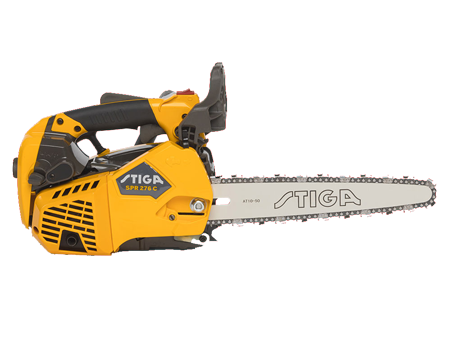
Chainsaw for pruning with carving blade
The bar on a chainsaw, also known as blade, is the metal component that acts as a guide for the chain. Its length must always be proportionate to the scope of work to be carried out, the diameter of the branches to be cut and the hardness of the wood.
Chainsaws for pruning can be fitted with two different types of bar: standard bar or carving bar.
The standard bar can normally be found in traditional chainsaws, and is characterised by its rounded tip, with a bearing at the end.
The carving bar is typical of pruning chainsaws. This blade has a peculiar shape, with a tapered tip. Because of this feature, chainsaws with a carving bar are more suitable for one-handed operation. In addition, the carving blade enables cleaner and much more precise cuts to be made.
A further benefit of the carving bar is its much greater safety. In fact, this bar prevents the risk of a rebound or a kickback. These phenomena are unfortunately quite common, especially for those operating a chainsaw with a standard bar.
They occur when the chainsaw tip hits a solid obstacle or gets caught in the branch. In these cases, the blade may bounce back to the operator.
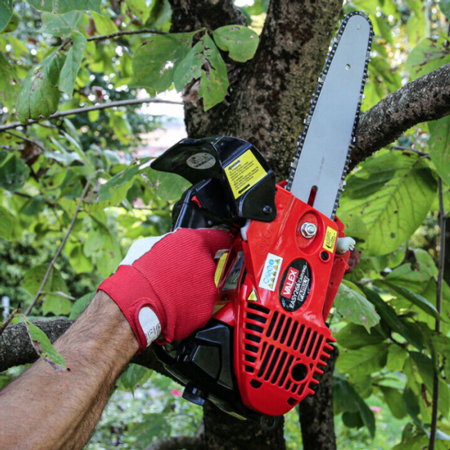
The carving bar, being narrow at the tip, instead penetrates the branch like a needle and facilitates cutting, without the risk of getting stuck inside. Fortunately, most chainsaws on the market today are also equipped with a chain brake: a safety system that, in the event of a kickback, is triggered automatically and causes the chain to stop instantly.
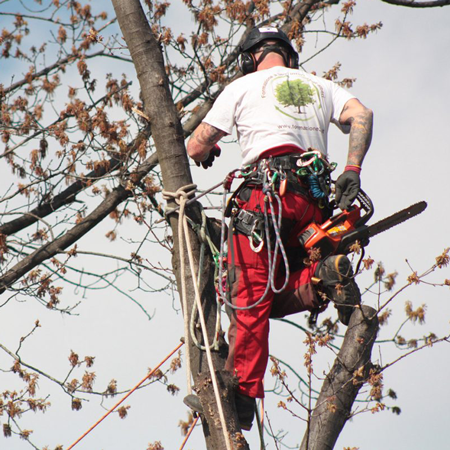
The carving blade, being thin and better able to sink into the bark of branches, is a popular choice among pruners performing tree climbing.
This term encompasses all techniques for working on the highest branches of trees. The so-called “tree climbers”, in fact, climb the tree tops using ropes, harnesses and helmets.
A pruner who does this must be able to rely on a lightweight and practical tool. The slender shape of a chainsaw with carving bar can guarantee the best result for those who want to work in total comfort and maximum safety.
There are also many wood sculptors today who use a pruning chainsaw to create their work. Originated in the 1950s in the USA, chainsaw carving is now also very popular in Europe.
The accuracy of the shapes and the refinement of the details demonstrate the degree of precision in the cuts offered by a carving blade.
To carry out this cutting and carving work, a carving bar without a head bearing is undoubtedly the most suitable solution for lovers of this art.
The absence of the bearing prevents the tip from overheating during carving operations. This gives you the opportunity to create true masterpieces with the utmost accuracy.
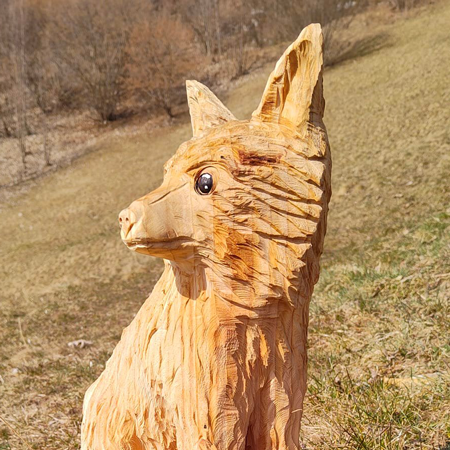
4. The advantages of purchasing a chainsaw for pruning
The advantages of using a chainsaw for pruning are numerous, and make it much easier to cut branches. What are the main benefits that come from using these tools?
- Chainsaws for pruning are much more compact than conventional models. Their smaller volume makes them more manageable and easier to handle, especially for less experienced users.
- These tools have a very low weight, even compared to small-displacement chainsaws for cutting. This allows these machines to be used in prolonged work sessions without too much fatigue.
- The bars mounted on a chainsaw for pruning are much shorter than those fitted to chainsaws for cutting. This enhances their practicality and improves their weight and balance.
5. Major brands
Before proceeding with the purchase of a chainsaw for pruning, it is important to take into account the most professional and well-known brands in the world of pruning and wood cutting equipment. Choosing a reliable manufacturer gives the user the certainty of a safe and quality-certified tool to carry out work in a smooth and trouble-free manner.
The recommended brands, for both hobby and heavy-duty models, are: Echo, IBEA, Efco, Alpina and Makita.
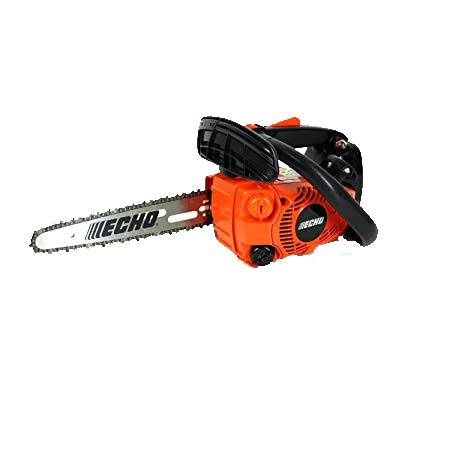
ECHO Chainsaws for pruning 
IBEA Chainsaws for pruning 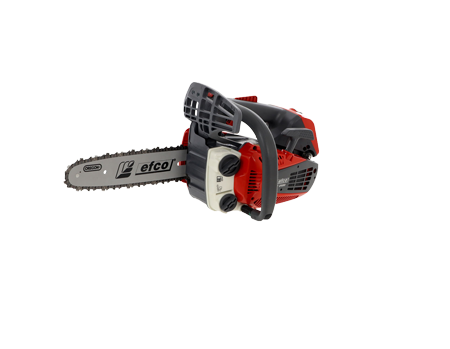
Efco Chainsaws for pruning
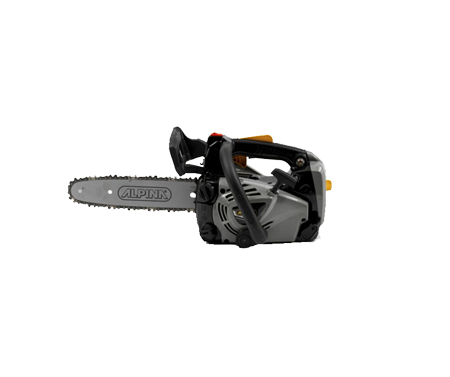
Alpina Chainsaws for pruning 
Makita Chainsaws for pruning
The following table shows the most representative models of chainsaws for pruning by the above-mentioned manufacturers.
If you are interested in purchasing a chainsaw for pruning and are unsure which one is the most suitable for you, we suggest you read our purchasing guide to the best chainsaws.



